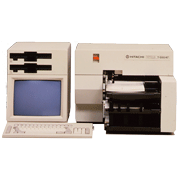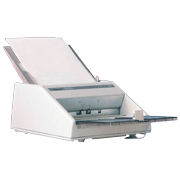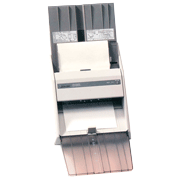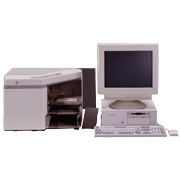The HITAC T-550/47 OCR system, announced in March 1984, was Japan’s first desktop optical character reader designed with the assumption that the control unit, the character recognition unit, and the sensor unit would all be placed on a desk. The T-550/47 packed two functions into one system: a document reader function that could quickly read large quantities of small forms such as deposit slips or meter-reading cards (turnaround forms) and a page reader function that could read various formatted slips ranging in size from small forms to large forms. This functionality allowed the T-500/47 to support a wide array of applications.
The HITAC T-550/47 OCR system addressed the need for a compact, high-performance optical character reader at a time when optical character readers were being installed in large numbers at branch stores, branch offices, and sales offices where space was at a premium. Applications included entering insurance contract applications at insurance company branches, entering tax notices at municipal offices, and entering delivery slips at distribution company offices. The outline boxes were made smaller so that OCR forms could be made in nearly the same size and format as original forms, and forms could be designed using table outlines for frequently used numerical fields.
| Readable characters | OCR-B font (numbers, letters, and symbols), dot matrix numbers and letters, 407 font Handwritten numbers, letters, katakana characters, and symbols |
|---|---|
| Readable forms | T-550/47: A8 to B4 portrait, paper weight between 55 and 135 kilograms, red dropout color T-550/27: A8 to B4, paper weight between 45 and 135 kilograms, red and blue dropout colors |
| Processing speeds | Document mode T-550/47: Maximum 〜220 sheets per minute (when reading 10 handwritten characters on an A8 form)) T-550/27: Maximum 〜110 sheets per minute (when reading 10 handwritten characters on an A8 form) Page mode T-550/47: Maximum 〜25 sheets per minute (when reading 100 handwritten characters on an A5 form) T-550/27: Maximum 〜20 sheets per minute (when reading 100 handwritten characters on an A5 form) |
| Sales launch period | T-550/47: March 1984, T-550/27: November 1984 |
Hitachi announced the lower-end model, the HITAC T-550/27 OCR system, in November 1984, which had enhanced page reader functionality. Although the document mode’s maximum processing speed was cut by half to about 110 sheets per minute (when reading 10 handwritten characters on an A8 form), it was possible to read landscape-oriented forms as well as portrait-oriented forms and either red or blue could be used as the dropout color. The T-550/27 also handled thin 45-kilogram-weight paper, thereby making it possible to read photocopied forms.
Hitachi began selling the Workstation OCR HT-4171 in September 1985, which could be connected to Hitachi’s personal workstation 2020. This was a top-class compact model suitable for installations at sales offices or customer-service desks.
Hitachi began selling the Workstation OCR HT-4175 and HT-4176 in April 1989. These models, which could be connected to Hitachi’s creative workstation 2050/32, contained both page reader and document reader functionality and offered top-class performance in both areas. In document mode in particular, the models achieved a maximum speed of about 250 sheets per minute, the fastest of any Japanese optical character reader at the time. They also supported reading forms with black table outlines created by laser beam printers or by hand, making it easy to add OCR capability to non-structured work operations.
An efficient recognition technique, such as hierarchal sorting, was needed to address the pressing need to recognize the many kanji characters used in addresses and names. In recognition of this need, Hitachi developed its own hierarchal characteristic structure matching technique for reading handwritten kanji characters on the HT-4175 and HT-4176. This allowed the models to read about 2,400 handwritten kanji characters, considered sufficient for most real-world applications, by adding support for kanji characters frequently used in names and place names to the standard kanji characters.





